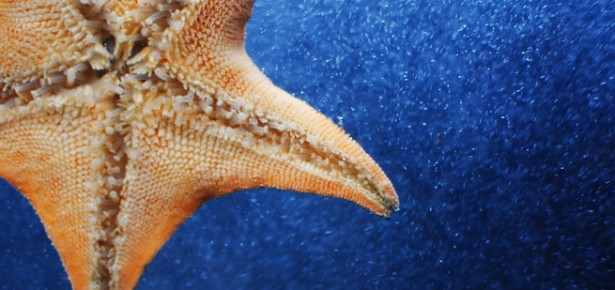
Orange Starfish. Photo: Lisa Williams via Creative Commons.
My previous post was about evolutionary process, but what about its partner, evolutionary pattern?
The animal kingdom, in time-extended form, takes the shape of (ironically) a tree. Ever since Darwin (and some would say earlier) we’ve been trying to figure out the exact structure of this tree.
We’re now getting close. Some early proposals of ‘close cousin’ relationships, for example (and at first sight bizarrely) vertebrates and starfish, have stood the test of time. Others have not – for example the old idea that insects and other arthropods were closely related to the segmented worms (including the familiar earthworm) has been ditched. And, to link in with the embryo stories of my last two posts, embryos have often been at the heart of both confirmations and revisions of various branches of the animal tree.
For example, humans and starfish, despite our disparate adult forms, have a similar pattern of cell division right at the embryological start of our (very different) lifecycles. And when the insects and segmented worms parted company due to our rethinking the tree, they did so because of another developmental, albeit not embryonic, characteristic – growth by moulting (insects yes, segmented worms no).
These days, much of the information we use to construct trees is DNA sequence data. When that and embryogenesis tell the same story, we’re pretty sure we have the right answer. If they don’t, that’s a problem, and the wisest solution is to collect more data (more genes, more embryonic features). When the story of any one branch becomes clear, we can move on to another. In this way, we are likely to have a firm grasp of exactly which routes animal evolution took and which it did not, in the near future.
Trees, however, can carry unwanted philosophical baggage. Sometimes a pointy-topped conifer, like a Christmas tree, has been used to picture animal relationships.
But in that case who goes at the top?
Well, generally when that particular shape has been used, we (humans) do. But this can be taken to imply a goal-directedness of evolution: its main goal was to produce us, and the other members of the animal kingdom are mere side-branches.
This view is egotistical twaddle, of course, so increasingly a flat-topped tree is used and we put humans on any of the terminal twigs – though preferably not the central one…
But wait a minute, surely we are special in some way or other, even if evolution did not spend over three billion years trying desperately to produce us? Surely we’re different from all other animals in some unique way? After all, we write and read books on evolution, which earthworms and starfish (and even chimps) do not.
Does human evolution require some additional, special, explanation that does not apply to the rest of our kingdom?
The two great founders of the theory of natural selection, Darwin and Wallace, disagreed about this: Wallace thought the answer was ‘yes’. Darwin thought ‘no’.
That fascinating difference of opinion will be the subject of my next (and final) post, in about a week’s time.
Latest Comments
Have your say!